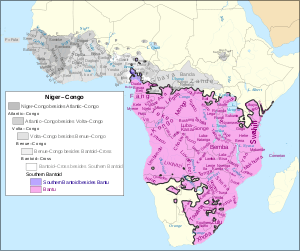Southern Bantoid languages
| Southern Bantoid | |
|---|---|
| Wide Bantu | |
| Geographic distribution | Sub-Saharan Africa, but not further west than Nigeria |
| Linguistic classification |
|
| Subdivisions |
|
| Glottolog | sout3152[1] |
|
The Southern Bantoid languages shown within the Niger–Congo language family. Non-Southern Bantoid languages are greyscale. | |
Southern Bantoid (or South Bantoid), also known as Wide Bantu or Bin, is a branch of the Benue–Congo languages of the Niger–Congo language family. It consists of several small branches and isolates of eastern Nigeria and west-central Cameroon (though the affiliation of some branches is uncertain) along with the Bantu languages (also called Narrow Bantu), which are spoken across most of Sub-Saharan Africa. As a result, Southern Bantoid comprises 643 languages as counted by Ethnologue, though many of these are mutually intelligible.
Southern Bantoid was first introduced in Williamson (1989, based on work presented in Blench [1987]) in a proposal that divided Bantoid into North and South branches.[2] The unity of the North Bantoid group was subsequently called into question, and Bantoid itself may be polyphyletic, but the work did establish Southern Bantoid as a valid genetic unit, something that has not happened for (Narrow) Bantu itself.[3]
According to Williamson and Blench (2000:34–5), Southern Bantoid is divided into the various Narrow Bantu languages, Jarawan, Tivoid, Beboid, Mamfe (Nyang), Grassfields and Ekoid families.[4] The Bendi languages are of uncertain classification; they have traditionally been classed as Cross River, but they may actually be Southern Bantoid.[5] Blench (2010) suggests that Tivoid, Momo (ex-Grassfields) and East Beboid may form a group, perhaps with the uncertain languages Esimbi and Buru:[6]
- ? Bendi
- Tivoid–Beboid: Tivoid, Esimbi, East Beboid, ? Momo, ? Buru, ? Menchum
- Furu (with Beboid?)
- Mamfe
- Ekoid–Mbe: Ekoid, Mbe
- West Beboid (not a valid clade?)
- Bantu: Grassfields (? Momo), Jarawan–Mbam, Narrow Bantu
References
- ↑ Hammarström, Harald; Forkel, Robert; Haspelmath, Martin; Bank, Sebastian, eds. (2016). "Southern Bantoid". Glottolog 2.7. Jena: Max Planck Institute for the Science of Human History.
- ↑ Williamson, Kay (1989) 'Niger–Congo Overview'. In: The Niger–Congo languages, ed. by John Bendor-Samuel, 3–45. University Press of America.
- ↑ Roger Blench. "Niger-Congo classification : Niger-Congo: an alternative view" (PDF). Rogerblench.info. Retrieved 2017-07-07.
- ↑ Williamson, Kay & Blench, Roger (2000) 'Niger–Congo', in Heine, Bernd and Nurse, Derek (eds) African Languages – An Introduction. Cambridge: Cambridge University press, pp. 11–42.
- ↑ Blench, Roger (2011). "'The membership and internal structure of Bantoid and the border with Bantu" (PDF). Berlin: Humboldt University. p. 17.
- ↑ Blench, Roger (2010). "The Tivoid Languages" (PDF). pp. 12, 15.

